Bottled water, especially bottled spring water, is the best for drinking. Although buying bottled water is less economical than installing a water filter, no other type of water can match the benefits of the essential minerals of bottled spring water.
Yet, the market is saturated with brands making bold claims regarding their water. While enthusiastic, not all of them are reliable, and some don’t even meet the standards set by the Environmental Protection Agency or the United States Food and Drugs Administration.
But there’s no need to worry, as we researched many bottled water brands to put together a list of the 15 best brands in 2023.
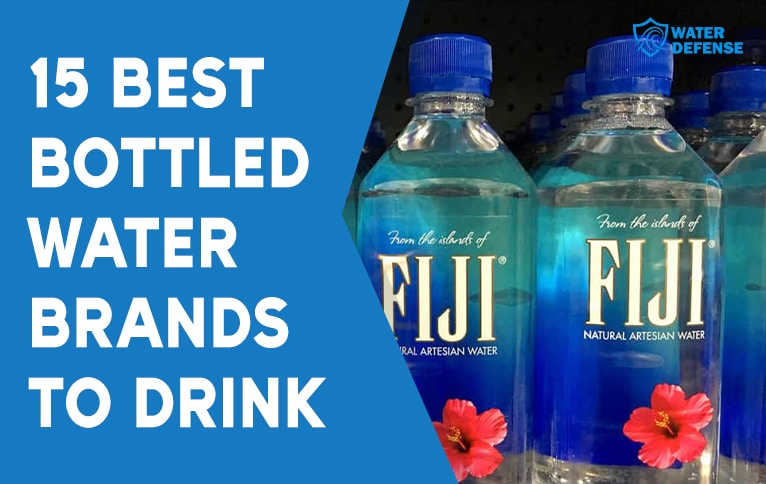
Our absolute favorite among those is the Mountain Valley Spring Water. However, the other items on our list (in no particular order) are worth exploring, too.
1. Mountain Valley Spring Water
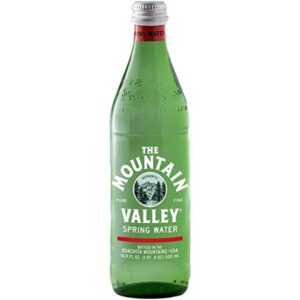
- pH: 7.3-7.7
- Total dissolved solids: 220 mg/L
- Calcium: 67 mg/L
- Magnesium: 7.1 mg/L
- Potassium: 1.3 mg/L
- Sodium: None
- Directly bottled at the source
- Natural filtration through granite
- Balanced pH levels
- 67 mg/L calcium
- No sodium whatsoever
- Aluminum or glass bottling
- Award-winning brand
- None
Mountain Valley Spring Water is the best bottled water on the market due to its balanced pH, calcium, magnesium, and potassium content. It’s also directly bottled at the source without interference — meaning it’s organic. That’s why it’s been many Americans’ primary drinking water choice since 1871.
Mountain Valley is located in the Ouachita Mountains within the borders of Arkansas. The water flows through naturally formed granite-based aquifers. The granite presence in the aquifers acts as natural filtration as it absorbs and adsorbs common contaminants and increases the water’s mineral content.
As a result, the Mountain Valley Spring Water entertains 220 mg/L of total dissolved solids (in this case, all minerals), which is only 30 mg/L short of being labeled as mineral water.
Calcium is the top mineral present, at 67 mg/L. Magnesium and potassium follow with 7.1 mg/L and 1.3 mg/L, respectively.
You may have heard that some spring water naturally contains sodium, which is harmful to people with cardiac conditions. Fortunately, Mountain Valley has no sodium, so it’s the ideal choice for everyone.
The pH of the Mountain Valley Spring Water ranges between 7.3 and 7.7. This means it’s neither acidic nor alkaline, offering a perfect balance.
The company bottles its water either in glass or recyclable aluminum bottles. The practice makes the brand eco-friendly, so you needn’t worry about microplastics leaching into your water from plastic bottles.
If our word alone isn’t good enough for you, you’ll be happy to know that the brand has won many awards since its conception. For the complete list, you can visit their website.
2. Acqua Panna
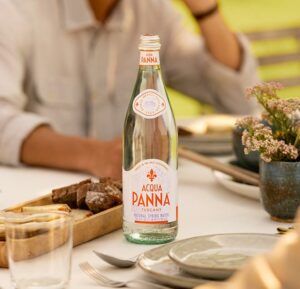
- pH: 8.8
- Total dissolved solids: 188 mg/L
- Bicarbonates: 106 mg/L
- Calcium: 31.5 mg/L
- Magnesium: 6.5 mg/L
- Potassium: 0.8 mg/L
- Sodium: 6.5 mg/L
- Nitrate: 2.9 mg/L
- Untouched and uncontaminated since 1564
- Unique taste thanks to its balanced mineral content
- High bicarbonate levels
- Naturally alkaline
- The choice of gourmets and high-end restaurants
- It contains sodium and nitrate, albeit in low levels
The discovery of the Acqua Panna springs in the hills of Tuscany, Italy, dates even further back than the discovery of Mountain Valley. Since 1564, Tuscany’s springs have miraculously been untouched and uncontaminated, continuing to awe with their unique taste.
Acqua Panna is the number #1 pick of many high-end restaurants thanks to its soft and velvety savor. This savor is indebted to the balanced mineral content of the water, which is a natural result of the underground waterways it travels through.
Although Acqua Panna doesn’t have as high a total dissolved solids (TDS) level as Mountain Valley Spring Water, it’s organically alkaline thanks to its high bicarbonate content.
Due to the 106 mg/L of bicarbonate, it entertains a pH level of 8.8. This makes it the right drinking choice if you want to reap the antioxidant benefits of alkaline water.
Yet, despite its high pH and bicarbonate levels, Acqua Panna doesn’t taste bitter due to its balanced mineral content. The minerals that give the water a bitter taste (calcium, potassium, sodium, and magnesium) range between 6 mg/L to 31.5 mg/L.
Aquasana is advertised as a luxury item in restaurants thanks to its glass bottles, but it also comes in more budget-friendly plastic bottles. Although plastics are unbecoming of this high-quality water, the plastic packaging is made of completely recyclable polyethylene terephthalate (PET).
Finally, Acqua Panna contains 2.9 mg/L of nitrates, which is well within EPA guidelines. However, it’s not completely free of them.
Additionally, it features 6.5 mg/L of sodium, so people on no-sodium diets should go with a different brand.
3. Icelandic Glacial Water
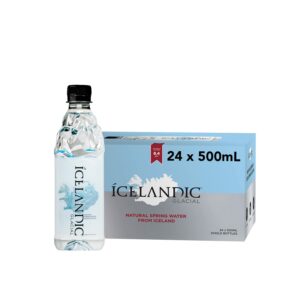
- pH: 8.4
- Total dissolved solids: 62 mg/L
- Bicarbonates: 27.6 mg/L
- Calcium: 5.7 mg/L
- Magnesium: 2.2 mg/L
- Potassium: 0.7 mg/L
- Sodium: 11 mg/L
- Nitrate: 0.02 mg/L
- Naturally alkaline with 8.4 pH
- Naturally filtered for thousands of years
- Only 62 mg/L total dissolved solids, so it tastes purer than other bottled water
- Carbon-neutral production
- Recyclable packaging
- Award-winning bottle designs
- 11 mg/L sodium
- Low on healthy minerals
It’s rare for alkaline water to go through only natural filtration processes and to have low mineral content, but that’s precisely what Icelandic Glacial Water represents.
Iceland is known for its exceptional landscape and is the home of Icelandic Glacial Water.
The aquifer of the Ölfus Springs, where the water is bottled, is located inside a lava rock formation. The rainwater falls on lava rock, which removes impurities and gives it a bicarbonate content of 27.16 mg/L. Thanks to this, the water is alkaline with a pH of 8.4.
The journey of the rainwater from the surface to the aquifer takes thousands of years, so it’s the best kind of natural filtration.
Due to the unique and relatively mineral-free structure of the lava rock, the water doesn’t have many minerals, distinguishing it from other bottled spring water brands.
Icelandic Glacial Water only has 62 mg/L of total dissolved solids, which is a testament to its low-mineral body.
Mineral levels in water range between 0 mg/L to 11 mg/L, with sodium occupying the top spot (see the full list). As a result of its low mineral content, this water tastes less bitter than the other two items we reviewed above.
The production of this bottled water is carbon-neutral as the company uses geothermal and hydroelectric power. Also, the bottles are made of 100% recyclable, BPA-free, and high-quality PET, contributing to the brand’s eco-friendliness.
If aesthetics are important to you, you’ll be happy to know that Icelandic Glacial has unique and award-winning bottle designs.
However, we should note that the low mineral content of the water from this brand isn’t necessarily an advantage, especially considering that the average American diet is already low in calcium and magnesium. Because of this, it’s beneficial to consume these healthy minerals through our drinking water.
4. Gerolsteiner Naturell
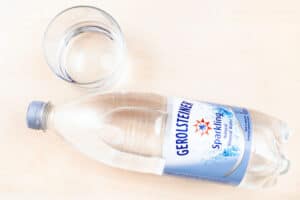
- pH: 5.9
- Total dissolved solids: 2,527 mg/l
- Bicarbonates: 1,816 mg/L
- Calcium: 348 mg/L
- Magnesium: 108 mg/L
- Potassium: 11 mg/L
- Sodium: 118 mg/L
- Chloride: 40 mg/L
- Sulfate: 38 mg/L
- Very high in healthy minerals
- Naturally filtered through volcanic craters
- 348 mg/L calcium and 108 mg/L magnesium
- Rich taste
- Some may find it bitter
- 118 mg/L sodium
Are you put off by the low mineral content of the Icelandic Glacial Water? Then, Gerolsteiner Naturell is the antidote for you. In just one liter of Gerolsteiner Naturell, there are enough minerals to get you almost halfway to the daily mineral intake recommended by nutritionists.
Gerolsteiner Naturell is bottled at Volcanic Eifel, a region in Germany full of volcanic craters, pumice, and basalt lakes at the Rhenish Slate Mountains in Rheinland-Pfalz. Thanks to its journey through these volcanic formations, the water is naturally filtered.
Gerolsteiner Naturell is rich in bicarbonate content, but the volcanic formations it passes through provide it with lots of carbon, making it acidic. As such, it has a pH of 5.9.
But what makes it unique is its TDS levels of 2,527 mg/l. Thanks to the mineral-rich character of the volcanic craters, Gerolsteiner Naturell probably takes the crown for being the most mineral-rich bottled water on the market.
It also contains 348 mg/L of calcium, almost half the recommended daily requirement. At 108 mg/L, its magnesium content is no less impressive, equalling a quarter of our daily magnesium needs.
Yet, Gerolsteiner Naturell is also very high in sodium, with 118 mg/L, so it’s not ideal for people with cardiovascular problems.
Thanks to its mineral profile, this particular water has a vibrant and bold taste which people who like their water neutral might not like.
Finally, like Acqua Panna, Gerolsteiner Naturell comes in either glass or PET bottles. The PET bottles are entirely BPA-free and recyclable but rare, so it’s likely that you’ll only come across glass Gerolsteiner Naturell bottles.
5. Waiākea Hawaiian Volcanic Water
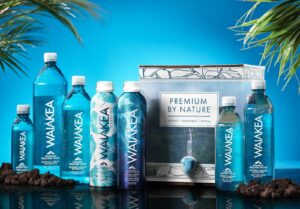
- pH: 7.6-8.2
- Total dissolved solids: 82 mg/l
- Bicarbonates: 34 mg/L
- Calcium: 7 mg/L
- Magnesium: 4 mg/L
- Potassium: 2 mg/L
- Sodium: 7 mg/L
- Silica: 44 mg/L
- Sulfate: 4 mg/L
- Naturally alkaline water
- Naturally filtered through volcanic craters
- Sweet and smooth taste thanks to its silica content
- Balanced mineral structure
- Carbon-neutral production
- Eco-friendly brand
- Low in healthy minerals
- Hard to find outside the United States
Similar to Gerolsteiner Naturell, the Waiākea Hawaiian Volcanic Water passes through volcanic craters before the bottling process. Yet, it’s almost the opposite of the former, with much lower TDS levels, higher pH, and a slightly sweet and very smooth taste and texture.
The water originates from and is bottled in Hawaii. The water source is on the Big Island at a deep well near the still-active Mauna Loa volcano.
Waiākea has been well-protected from external contamination since it’s thousands of miles from industrial activities and human and animal waste. In addition, the volcanic formations eliminate the natural contaminants found in rainwater, so the brand bottles its water directly at the source without any interference.
The volcanic formations also enrich the water with minerals, albeit in a low and balanced manner. It has 82 mg/L of TDS, and minerals such as calcium and magnesium are 2 mg/L to 7 mg/L.
The only standouts are bicarbonates (34 mg/L) and silica (44 mg/L). While the former give it a bit of alkalinity (pH ranging from 7.6 to 8.2), the latter give it a pleasant smooth and sweet taste.
Similar to the Icelandic Glacial Water, Waiākea bottles its water in a carbon-neutral and sustainable fashion. The packaging is also in line with the eco-friendly principles of the brand, as the water comes in recycled aluminum, Oceanplast (the brand’s recycled PET bottling), and reusable bags placed in a box.
Even better, the company is involved in many charity organizations and clean water initiatives, impacting thousands of lives and emphasizing ethical business practices. You can learn more about these activities on their website.
When it comes to the downsides, the biggest one is that some people may not like the low mineral content of Waiākea.
Plus, the brand is hard to come by outside the US. So, if you’re frequently traveling abroad, it may not be accessible.
6. FIJI Water
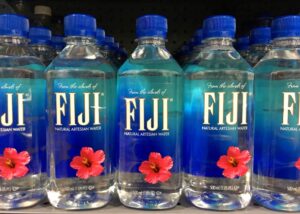
- pH: 7.7
- Total dissolved solids: 222 mg/l
- Calcium: 17.9 mg/L
- Magnesium: 14.7 mg/L
- Potassium: 4.9 mg/L
- Sodium: 17.8 mg/L
- Silica: 93.4 mg/L
- Chloride: 9.3 mg/L
- Fluoride: 0.2 mg/L
- The smoothest-tasting water
- Naturally filtered through dormant volcanoes
- The source is protected from potential contamination
- 93.4 mg/L silica is the highest silica content in bottled water
- Slightly alkaline
- Balanced healthy mineral body
- Sustainable and local-friendly brand
- Only comes in PET bottles
- Contains sodium and fluoride
FIJI Water is naturally filtered through ancient and dormant volcanic craters on Viti Levu (the largest crater on the Fiji Islands).
The craters are 1,600 miles away from human or industrial contamination and are rich in silica, so the water you drink is not only pure but also sweet and smooth.
FIJI Water is collected directly from underground volcanic aquifers filled with rainwater over centuries. The rainwater is also pure since the equatorial trade winds blowing over the Fiji Islands cleanse the clouds.
In terms of nutrition, the FIJI Water is richer than Waiākea, with 222 mg/L of TDS. In addition, it has 14.7 mg/L of magnesium and 17.9 mg/L of calcium.
Still, what makes it one of the most popular artesian water brands in the world and the choice of many celebrities is its silica content. This particular water brand has 93.4 milligrams of silica per liter, the highest number among its competitors, making it more pleasant and smoother than other brands.
In addition, it has a 7.7 pH, meaning it’s slightly alkaline.
Like the Waiākea company, FIJI is involved in local philanthropy, emphasizing sustainability and improving the life quality of the natives of the islands. Additionally, the company runs several programs, including initiatives to provide clean water and healthcare for underprivileged communities, build infrastructure and educational facilities, and conserve the ecosystem of the Fiji Islands.
However, FIJI Water is only available in PET bottles, which doesn’t suit such a high-end brand.
Lastly, the water contains 17.8 mg/L of sodium and 0.2 mg/L of fluoride, making it the wrong choice for those who want sodium- and fluoride-free water.
7. Saratoga Natural Spring Water
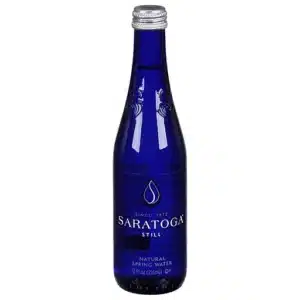
- pH: 7
- Total dissolved solids: 74 mg/l
- Calcium: –
- Magnesium: –
- Potassium: –
- Sodium: –
- Silica: –
- Chloride: –
- Fluoride: –
- Light and smooth
- Prestigious American brand
- Low TDS
- Neutral pH
- Elegant bottling
- Expensive
- Hard to find
- The brand website offers little info
Saratoga Springs is a town in New York renowned for the 21 high-quality springs scattered around it. So, it would be a surprise if some of the best water in the world didn’t originate from this town. The Saratoga Natural Spring Water covers that ground with its low mineral content, light taste, and smooth feel.
The origins of the springs in Saratoga date back to the Paleozoic era when the bedrock underlying the surface cracked in various places, forcing the water below to reach above the surface. The natives believed the water had healing powers, and the settlers turned the area into a spa haven in the 1800s. Since then, the Saratoga spring water has been bottled for consumption, too.
Nowadays, what Saratoga Natural Spring Water offers is a premium drinking experience promoted by high-end restaurants and influencers. There’s also truth to this marketing, as Saratoga is probably the best luxury water brand in the United States.
As we said, it’s a low-mineral brand with a TDS of 74 mg/L, so it tastes lighter than most bottles on our list. In addition, it has a neutral pH of 7, meaning it’s neither acidic nor alkaline.
The Saratoga water comes in two forms: still (bottled directly at the source) and sparkling. The former is a premium drinking water choice, and the latter is typically paired with many heavy dishes (like steak) as an excellent non-alcoholic alternative to champagne.
Its cobalt blue glass bottles, reminiscent of champagne bottles, are a testament to its premium status.
Saratoga is one of the most expensive bottled water brands around. You’re also unlikely to come across it anywhere other than in high-end restaurants.
On a final note, the brand website offers little information on the nutritional values of its water or how it’s sourced.
8. Evian
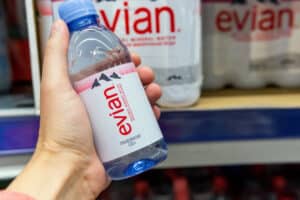
- pH: 7.2
- Total dissolved solids: 345 mg/l
- Bicarbonates: 360 mg/L
- Calcium: 80 mg/L
- Magnesium: 26 mg/L
- Potassium: 1 mg/L
- Silica: 15 mg/L
- Chloride: 10 mg/L
- Sulfates: 14 mg/L
- High-mineral still water with 345 mg/L of TDS
- Fifteen years of natural filtration through glaciers and rocks
- High levels of electrolytes (bicarbonates, calcium, magnesium)
- Mouthful taste
- Neutral pH
- Sustainable production
- It’s an acquired taste
Evian is popular among celebrities and influencers. It’s expensive, but its quality is uncontested.
Evian originates from France, namely the town of Évian-les-Bains near the French Alps. The snowmelt from the French Alps passes through layers of glaciers and rock formations that naturally filter it and provide it with many minerals.
The journey of the water takes fifteen years. Although that number is much less than what Waiākea and FIJI waters have, it’s still enough for thorough natural filtration and it’s what gives it its high mineral content.
Evian’s 345 mg/L of TDS, 80 mg/L of calcium, 26 mg/L of magnesium, and, most impressively, 360 mg/L of bicarbonate content is evidence of that. Yet, it has only 15 mg/L silica.
A high mineral count with low silica means this water tastes more bitter. While some find the taste appealing, it could be off-putting for others.
Even though it’s mineral-rich, Evian has an excellent balance of alkalis and acids, making it pH-neutral at 7.2.
In a similar vein to many other spring water brands on our list, Evian also emphasizes sustainability. On their website, you may learn more about their actions on sustainable production, carbon neutrality, source protection, and climate crisis.
9. Penta Water
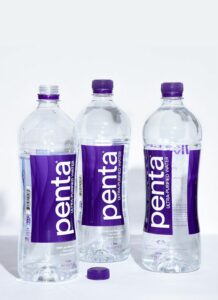
- pH: 6.10-7.12
- Total dissolved solids: Less than 1 mg/l
- Calcium: –
- Magnesium: –
- Potassium: –
- Sodium: –
- Silica: –
- Chloride: –
- Fluoride: –
- Purest bottled water on the market
- Heavily filtered in a 13-step process
- Tastes like nothing(ness)
- Heavily treated
- No taste
- No healthy minerals/electrolytes
Penta Water, which the brand advertises as the purest possible form of water, is bared down only to two parts hydrogen and one part oxygen. In other words, the water has less TDS than 1 mg/L and no minerals or contaminants at all.
Since it’s heavily treated, we won’t talk about how and where the water is collected — we’ll focus on Penta’s patented thirteen-step water purification process, which is what makes the water fully contaminant- and mineral-free.
This process entails various filtration methods (two undisclosed by the brand) to ensure their water consists of only hydrogen and oxygen.
- Four different microfiltration steps with filters varying in micron size, blocking large-particle impurities
- Two reverse osmosis stages, eliminating various contaminants, from heavy metals to perfluorinated chemicals
- Two deionization phases, removing all minerals
- Two ultraviolet disinfection processes that kill microorganisms such as bacteria and viruses
- And, finally, ozonation, which sterilizes the water before it’s packaged
The result is the purest water without contaminants, minerals, or taste.
The only real attribute of Penta Water is its pH, which varies between 6.10 to 7.12. It means it’s sometimes acidic and sometimes neutral, but it’s no surprise considering that reverse osmosis produces acidic water. The brand does nothing to alter the pH of its water.
Penta is the evident choice for those who want tasteless, contaminant-free, and mineral-free water. However, this character-free and heavily-treated water is a no-go for many.
10. Hildon Water
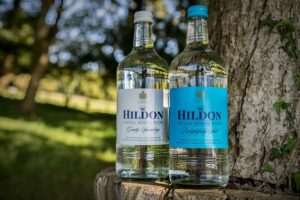
- pH: 7.3
- Total dissolved solids: 312 mg/L
- Bicarbonates: 136 mg/L
- Calcium: 97 mg/L
- Magnesium: 1.7 mg/L
- Potassium: None
- Sodium: 7.7 mg/L
- Silica: None
- Chloride: 16
- 50-year journey through chalk naturally filters it
- High-mineral content at 312 mg/L TDS
- 136 mg/L bicarbonates and 97 mg/L calcium
- Neutral pH
- Holds a Royal Warrant
- No silica
- Slightly bitter taste
- Only PET bottling
The Hildon Water is collected at the springs of the Hildon Estate, near the Broughton village and deep within the Test Valley in South East England. The water makes a 50-year journey through chalk that purifies and provides it with high mineral content.
Thanks to the success of that journey, the Hildon Water holds a Royal Warrant. It means the brand has served at least one of the three royal households in the United Kingdom for at least seven consecutive years.
So, if a bottled water brand is good for royalty, it must have some merit.
The Hildon Water has a balanced taste thanks to its equal alkaline and acidic content. As such, it has a neutral pH of 7.3, measured at its source.
Besides its neutral pH, it has an abundance of minerals, too, with a TDS of 312 mg/L. Among these minerals, electrolytes such as bicarbonates (136 mg/L) and calcium (97 mg/L) take the lead.
Yet, these minerals give the water a slightly heavy mouthfeel and bitter taste, which is not everyone’s cuppa. Additionally, the water contains no silica whatsoever, meaning it has no smoothness.
Lastly, Hildon Water is packaged only in PET bottles.
11. phURE Alkaline Water
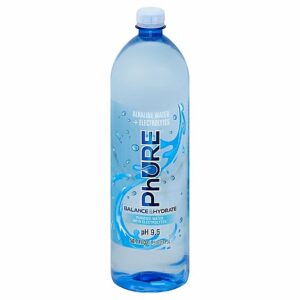
- pH: 7.3
- Total dissolved solids: –
- Bicarbonates: –
- Calcium: –
- Magnesium: –
- Potassium: –
- Sodium: –
- Silica: –
- Chloride: –
- The most alkaline water on the market
- It helps with acid reflux and oxidative damage
- Excellent choice for athletes
- Scientifically backed
- No sugar
- The brand offers no info on water ingredients and the ionization process
- Tastes bitter
Do you want to reap the benefits of alkaline water without breaking the bank on high-end water ionizers? Then, the phURE is what you’re looking for.
Alkaline water has many benefits. It works as an antioxidant that repairs or prevents the oxidative damage caused by air pollution and secondary smoking while relieving the symptoms of acid reflux. It also helps athletes recover more quickly due to its electrolyte content. These two things make it the primary drinking water choice for those who regularly engage in heavy exercise routines.
The phURE water is specifically manufactured for these purposes. It has a 9.5 pH, which makes it one of the most alkaline waters on the market.
The brand reaches that pH value by ionizing the water by adding free hydrogen molecules to raise its alkalinity. The brand claims the process is backed and monitored scientifically, and no sugar is added to the water.
Yet, phURE does little to inform customers about the ingredients they add to the water. Nor is there an ingredient list detailing healthy minerals inside the water anywhere on their site.
Lastly, although many phURE consumers enjoy the taste, water with 9.5 pH will inevitably be more bitter than those with neutral pH values.
12. Deer Park Spring Water
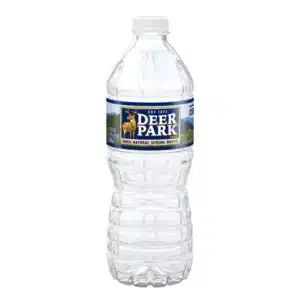
- pH: 5.5-7.7
- Total dissolved solids: 0-96 mg/L
- Bicarbonates: –
- Calcium: 0-20 mg/L
- Magnesium: 0-7.9 mg/L
- Potassium: –
- Sodium: 0-6.1 mg/L
- Silica: –
- Chloride: 0-17 mg/L
- Sources water from fourteen different American springs
- Affordable water
- Light taste
- The company protects its water sources
- Water quality changes due to spring difference
- Low in mineral content
Unlike many other spring water options on our list, Deer Park Spring Water doesn’t come from a single source. Instead, the American company uses fourteen of the greatest springs in the country to provide premium water at the cheaper end of the scale.
Eight springs are called Frontier Springs, located around Pennsylvania and Maryland. That’s also where the company got its start.
Swift Springs is one spring down south in Chesterfield County, South Carolina. The other five are in Florida.
You’ll be happy to know that the company employs sustainability experts to protect and preserve its sources.
Of course, such a wide range of springs means the water doesn’t have a consistent ingredient body. The TDS levels of the Deer Park water vary between none to 96 mg/L, leaning on the low end of calcium and magnesium content. Source changes also affect its pH, which ranges between 5.5 to 7.7.
Such values mean the water has a mainly light and smooth taste that also fluctuates from bottle to bottle. You can examine its water quality report for more information on the water quality.
13. Vichy Catalan
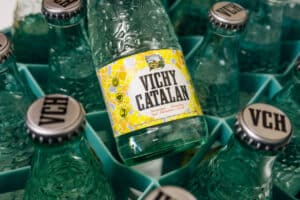
- pH: 8
- Total dissolved solids: 2,900 mg/L
- Bicarbonates: 2,081 mg/L
- Calcium: 14 mg/L
- Magnesium: 6 mg/L
- Potassium: 51 mg/L
- Sodium: 1,097 mg/L
- Silica: 15 mg/L
- Chloride: 584 mg/L
- Extremely high TDS count
- Heavy mineral content
- Naturally carbonated
- Emerges at 60 degrees Celsius
- Exceptionally high in potassium and chloride content
- Naturally alkaline
- Low in calcium and magnesium
- High in sodium
- Tastes salty
Vichy Catalan is the most famous mineral water hailing from Spain. The area of its two springs, Caldes de Malavella, has been populated by humans since prehistoric times.
Vichy Catalan water has the highest TDS levels, 2.900 mg/L, making it the most mineral-saturated. What’s better, the water naturally emerges at 60 degrees Celsius (140 degrees Fahrenheit) with natural gas inside, meaning it’s one of the most carbonated mineral water brands on the market.
Yet, it distinguishes itself from other mineral water brands with its mineral count. While most mineral water is rich in calcium and magnesium, that’s not the case with Vichy Catalan. It has 14 mg/L of calcium and 6 mg/L of calcium, almost on par with regular water types.
However, its strength lies in its potassium and chloride content. Vichy Catalan sports 51 mg/L of potassium and 584 mg/L of chloride, the highest on our list. Additionally, despite being naturally carbonated, it’s alkaline, with a pH of 8.
While those numbers are incredible and almost unmatched in the industry, Vichy Catalan is also the champion in sodium content with 1,097 mg/L. The high sodium levels mean it tastes salty — so salty that you may easily feel like you’ve mistakenly swallowed seawater.
Needless to say, it should be avoided by those on low- or no-sodium diets.
14. Antipodes
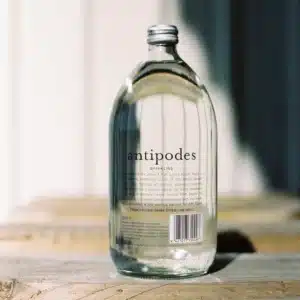
- pH: 7
- Total dissolved solids: 130 mg/L
- Bicarbonates: 37 mg/L
- Calcium: 3 mg/L
- Magnesium: –
- Potassium: 3.5 mg/L
- Sodium: 12 mg/L
- Silica: 76 mg/L
- Chloride: –
- Sulfates: 3 mg/L
- Water travels through ignimbrites
- High silica content
- Low in minerals
- Tastes light, sweet, and smooth
- Naturally neutral pH
- Sustainable, carbon-zero, and eco-friendly brand
- Low in healthy minerals
- Expensive
Antipodes, a natural spring water brand, comes from New Zealand. Thanks to its high silica content, it presents an excellent alternative to smooth-tasting water brands such as FIJI.
The aquifer Antipodes sources its water from sits at 327 meters below ground. The water journeys to this aquifer for 50 to 300 years through cooled volcanic rock formations, also known as ignimbrites.
Since ignimbrites are naturally high in silica content, they endow the Antipodes water with 76 mg/L of silica, giving it a smooth mouthfeel. That silica comprises most of its total dissolved solids (130 mg/L).
However, Antipodes has very little mineral presence besides silica. It doesn’t contain magnesium, its calcium content is only 3 mg/L, and it has only 37 mg/L of bicarbonates.
Yet, such low mineral content isn’t necessarily a disadvantage. On the contrary, low calcium and magnesium and high silica mean the water tastes lighter and sweeter than alternatives with higher calcium and magnesium and lower silica levels.
Additionally, Antipodes has a natural neutral pH of 7.
The brand has been certified as carbon-zero since 2007, and it prioritizes sustainability by using 100% renewable energy sources during production.
The employment of only glass bottles in distribution further reinforces its eco-friendly status.
On a final note, the brand is difficult to find and expensive. For example, one six-pack of one-liter Antipodes bottles costs about $60.
15. Liquid Death Mountain Water
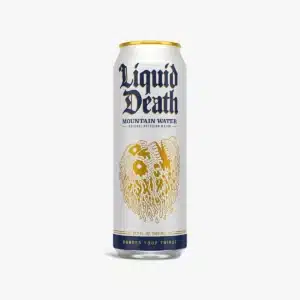
- pH: 7.89
- Total dissolved solids: 170 mg/L
- Calcium: –
- Magnesium: –
- Potassium: –
- Sodium: –
- Silica: –
- Chloride: –
- Fluoride: –
- Fun designs
- Naturally alkaline
- Aluminum packaging is eco-friendly
- 170 mg/L of TDS
- The company offers no info on the mineral content
For our last review, we picked something interesting. Liquid Death doesn’t shine with its mineral content, alkalinity, purity, or taste but with its punk stance and outlandish design choices.
First, though, let us give you the boring facts. The Liquid Death Mountain Water originates from the mountains of Austria. It’s collected directly from the springs, contains naturally occurring minerals (170 mg/L of TDS), and has a 7.89 pH, making it slightly alkaline. You can examine its water quality report for more info regarding its content.
Liquid Death sources its water from Austria but sells it mainly in the United States. Besides declaring contempt for corporate marketing, the brand uses two slogans for its advertising campaigns: “Murder Your Thirst” and “Death to Plastics,” which we stand behind.
To further reinforce their stance, they employ aluminum packaging. The Liquid Death Mountain Water is only available in aluminum cans (featuring death metal-esque skulls on their sleeves) that look like beer cans.
The brand produces sparkling water (pH 5.1) and iced tea alongside mountain water. Their website also features a special page for various merchandise, including cool (depending on your style choices) T-shirts, hats, and koozies.
While all that’s good and well, the brand offers little info on its water collection process, source, or mineral content of its water.
Frequently Asked Questions
Below are our answers to the biggest questions readers have about minerals in drinking water and alkalinity.
The minerals in drinking water are vital because drinking water is the primary source of some of them (calcium, magnesium, and potassium). Also, various studies report that an average American citizen’s intake of these minerals is way below the recommended levels. (See different studies on calcium, magnesium, and potassium intakes).
Let’s see how some of the minerals we mentioned during our reviews benefit our health.
Calcium: Calcium is essential for maintaining our muscle functions and bone health. Although some claim that we consume enough calcium through milk and vegetables, research suggests we absorb it the best directly from water.
Magnesium: Magnesium might be even more essential than calcium as it plays a big role in regulating nerve functions, blood pressure, and biochemical reactions.
Potassium: Potassium has a variety of health benefits, including heartbeat and blood pressure regulation, kidney activity, and urination.
Bicarbonates: The bicarbonate presence positively affects the water’s pH levels. In addition, it helps with fatigue and nausea, which makes bicarbonate-rich water preferable for athletes and after heavy workouts.
Chloride: Water rich in chloride is also the preferred choice of athletes as it improves nerve function and oxygen flow.
That said, we need to open up a parenthesis for sodium. Unlike the other minerals we mentioned, the average sodium intake in the United States isn’t below the recommended levels, on the contrary.
Additionally, sodium is harmful to those who have cardiovascular problems. So, it’s a good idea to avoid it.
Many water brands market their water as naturally alkaline. That’s because alkaline water has many health benefits:
The air pollution and the adverse health effects of secondary smoking are no longer up for scientific debate. However, you may not know that these two also produce toxic free radicals that lead to oxidative damage in our bodies and blood. Research shows alkaline water is a potent antioxidant, relieving the adverse effects of external oxidative damage.
Alkaline water improves blood flow due to its high bicarbonate levels. As healthy blood flow is crucial for muscle activities and cardiac health, it’s no wonder that alkaline water is athletes’ primary drinking water choice.
Americans consume too much sugar, dairy, and meat. While dishes containing those taste great, it also means our diet is highly acidic. Alkaline water, especially with high calcium levels, is an excellent drink for balancing our acidic diet.
Of course, an acidic diet has its adverse effects, too, such as acid reflux. Research suggests alkaline water prevents and helps against acid reflux.
There are also various claims regarding how alkaline water improves our immune systems, helps us lose weight, cleanses the colon, and assists with healthy aging. Yet, scientific research into these areas is scarce.

We have a right to know what is in our water this was very helpful thank you 😊😊